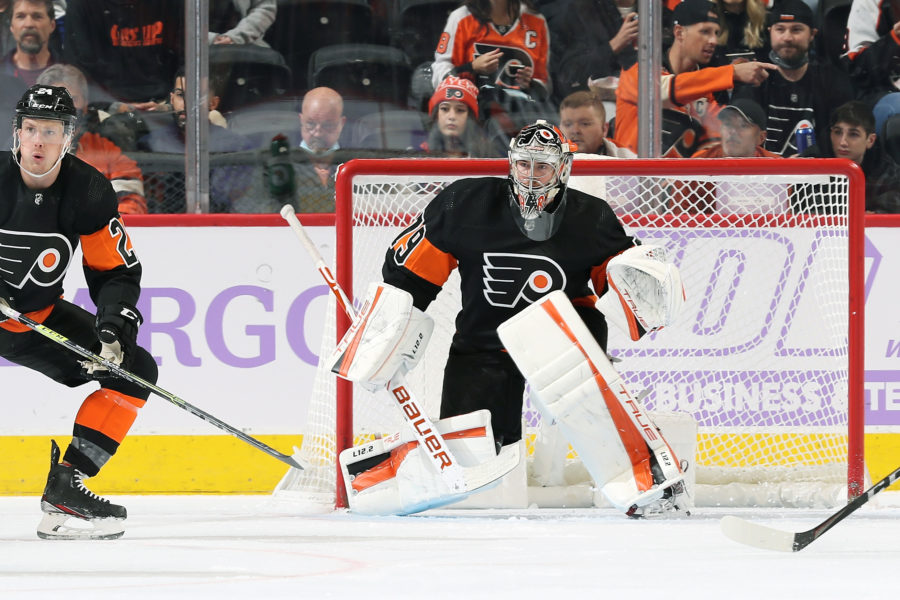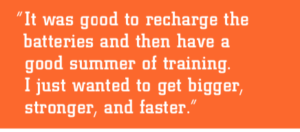
PHILADELPHIA, PA - NOVEMBER 18: Carter Hart #79 and Nick Seeler #24 of the Philadelphia Flyers defend their goal against the Tampa Bay Lightning at the Wells Fargo Center on November 18, 2021 in Philadelphia, Pennsylvania. (Photo by Len Redkoles/NHLI via Getty Images)
In the offseason, Flyers general manager Chuck Fletcher made a slew of moves as he tried to erase last year’s collapse and get the Orange and Black back into the playoffs.
Some of the moves were muted in the first part of the 2021-22 season, especially the deal that brought defenseman Ryan Ellis to the Flyers. Ellis was expected to be a top-pairing partner for Ivan Provorov and someone who would solidify the defense.
But an unspecified injury kept Ellis sidelined for most of the first couple of months, causing the Flyers to struggle to get into a playoff spot and Alain Vigneault to get fired after the team lost eight straight games.
There were few positives in the season’s first two months, but 23-year-old Carter Hart’s improved play was one of the exceptions. Hart’s mostly strong goaltending was even more impressive when you consider the Flyers had been without one of their best defensemen.
Heading into December, Hart had a 2.67 goals-against average and a .920 save percentage. He had made vast strides from last season when he was at the bottom of the NHL rankings with a 3.67 GAA and .877 save percentage.
“He seems in a real good place, mentally,” Vigneault said early this season.
In the first quarter of the season, Hart re-established himself as a franchise cornerstone, and once again looked like one of the NHL’s top young goalies.
In short, he gave the Flyers a chance to win. Night after night.
As the season reached the quarter pole, Hart was playing well despite the Flyers facing the most high-danger shots in the NHL per 60 minutes of 5-on-5 play, according to Natural Stat Trick.
But there was a marked difference in his results when compared to last season. The reason? Hart had a .883 save percentage on those high-danger shots this year. Last year, his save percentage was only .766 on those shots.
“You need your goalie to be good to have a good team,” forward Scott Laughton said in late November, “and I think (Hart’s) been outstanding for us.”
Hart’s revival got its roots early in the summer when he took some time off to clear his head.
“I needed a bit of a break after the season,” Hart said. “Just took a little bit of time off the ice. Had to recharge the batteries a bit, so it was good. Got into tennis a little bit in the summer and that was fun; it was good to recharge the batteries and then have a good summer of training. I just wanted to get bigger, stronger, and faster.”

“Clearly, last year he didn’t play as well as he had in the past, like the rest of our team,” Fletcher said. “Different circumstances, I think, impacted people differently. His track record to me showed that he’s been a good goaltender at every level for most of his life, and he worked hard at it this summer. He and (Flyers goalie coach) Kim Dillabaugh and his goalie coach back in Edmonton (Dustin Schwartz) got together, and they had a great plan.”
Hart’s early-season revival didn’t surprise Fletcher.
“Carter has always worked hard. He puts the time in, and he’s played well,” Fletcher said before a December game. “Personally, my expectation was that he was going to bounce back. He’s playing as one of the better goaltenders in the league right now and that’s great for us. It’s a tough position, but he’s a guy that we have a lot of faith in. You’ve got to give him credit for the work he put in…. Going forward here, we’re going to have to try to play better in front of him and have the puck a little bit more often because we’re putting a lot of pressure on our goaltenders right now.”
Last season, some of Hart’s struggles weren’t helped by the fact that COVID-19 caused him to be isolated from his teammates. The married players had company all the time. Hart, who is single, did not.
After last season, Hart admitted there were lonely times for him.
“You kind of go home and you’re just in your own thoughts the whole time because you just sit and sit in your apartment alone,” he said. “But things were a lot better at the end [of the season]. I was feeling a lot happier and hanging out with the boys more.”
Things are more normal this season as teams have returned to their familiar divisions and are playing the same schedule as before the pandemic altered things in 2020-21. That means there is a normal schedule with the usual travel, which enables players to bond over dinners and activities away from the rink.
Hart said he was “just enjoying the opportunity and having fun. It’s great being around the boys and things being more normal this year.”
The Alberta native seems more relaxed and focused this season.
“Last year, maybe sometimes I wasn’t grateful for the opportunity to be in the NHL,” he told Jason Myrtetus on Flyers Daily. “I think this year I’m having more fun and being grateful to be in the NHL, playing alongside the best players in the NHL and living the dream.”
And playing before packed arenas again, which, he said, has also been a boost after the pandemic limited crowd sizes last season.
“It’s nice hearing the boos again on the road,” he said with a laugh. “And at home, we feed off the fans’ energy.”
Hart, who signed a three-year contract extension in August that has an annual cap hit of $3.979 million, wasn’t the only goalie to struggle in his second full season. Far from it. The long list includes former standouts like Bernie Parent and Tim Thomas.
Parent’s second season in Boston was awful (3.65 GAA, .891 save percentage), but he rebounded the next year and had a 2.49 GAA and .926 save percentage with the Flyers. He led the Flyers to two Stanley Cups and is in the Hockey Hall of Fame.
Thomas struggled for Boston in his second full season (3.13, .905). He then turned into perhaps the game’s most dominating goalie over the next five seasons, twice leading the NHL in save percentage (.933, .938) and GAA (2.10, 2.00) in that span.
Hart hopes to follow a similar path.
“You have to go through adversity to get better and to grow,” Vigneault said early in the season, prior to being replaced by Mike Yeo. “He went through that probably for the first time in his life and his career.”
And learned from it.

